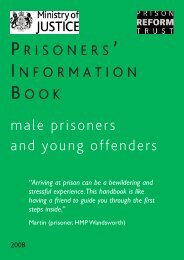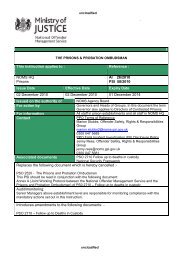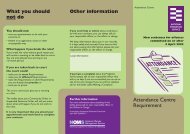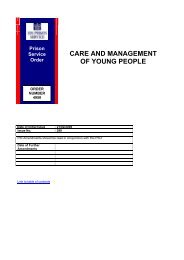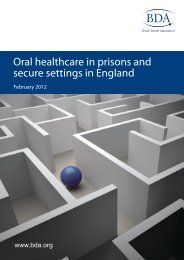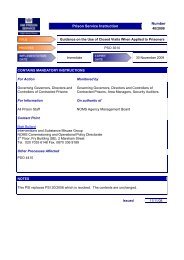Resettlement provision for children and young ... - Ministry of Justice
Resettlement provision for children and young ... - Ministry of Justice
Resettlement provision for children and young ... - Ministry of Justice
You also want an ePaper? Increase the reach of your titles
YUMPU automatically turns print PDFs into web optimized ePapers that Google loves.
Introduction<br />
<strong>Resettlement</strong> is one <strong>of</strong> the main tests against which the Inspectorate judges the health <strong>of</strong> a<br />
prison. This thematic review, commissioned by the Youth <strong>Justice</strong> Board, examines<br />
accommodation <strong>and</strong> education, training <strong>and</strong> employment (ETE) resettlement <strong>provision</strong> <strong>for</strong><br />
sentenced <strong>young</strong> men aged 15 to 18 in <strong>young</strong> <strong>of</strong>fender institutions. It reports on the work<br />
carried out in custody to prepare <strong>young</strong> people <strong>for</strong> release, using survey data as well as indepth<br />
interviews with 61 sentenced <strong>young</strong> men, their case supervisors <strong>and</strong> follow-up<br />
in<strong>for</strong>mation on what happened to them on release. The heads <strong>of</strong> resettlement <strong>and</strong> learning <strong>and</strong><br />
skills in each institution provide an establishment perspective.<br />
Ensuring that <strong>young</strong> people have suitable <strong>and</strong> sustainable accommodation <strong>and</strong> ETE on<br />
release from custody is a vital first step to reduce re<strong>of</strong>fending <strong>and</strong> enable <strong>young</strong> people to<br />
successfully reintegrate into the community. This is no small task – in our sample <strong>of</strong> 61 <strong>young</strong><br />
men more than eight out <strong>of</strong> 10 (84%) had an accommodation <strong>and</strong>/or ETE need identified. In<br />
our survey almost half <strong>of</strong> <strong>young</strong> men said they were under 14 when they were last at school<br />
<strong>and</strong> 86% said they had been excluded at some point.<br />
All establishments had a strategy to drive <strong>for</strong>ward resettlement work but in most cases these<br />
did not involve external agencies <strong>and</strong> had not been in<strong>for</strong>med by a recent needs analysis <strong>of</strong> the<br />
population. The training planning process should be central to coordinating work to address<br />
<strong>young</strong> people’s individual needs, with targets set <strong>for</strong> a <strong>young</strong> person’s time in custody <strong>and</strong><br />
plans <strong>for</strong> their release. We found from our fieldwork that several establishment case<br />
supervisors, who oversaw the training plan, had a good knowledge <strong>of</strong> the <strong>young</strong> people in their<br />
caseload. Most <strong>young</strong> men reported that training plan targets had been discussed with them,<br />
although less than two-thirds in our case sample knew what their targets were <strong>and</strong> only half<br />
said they had had a say in the targets set <strong>for</strong> them – this then had a real impact on whether<br />
they tried to achieve them.<br />
In custody, the range <strong>and</strong> quality <strong>of</strong> education <strong>and</strong> training <strong>provision</strong> was generally satisfactory<br />
<strong>and</strong> it was clear that, where possible, a <strong>young</strong> person’s preferences had been taken into<br />
account when allocating them to ETE. Most, although not all, <strong>young</strong> men said they were<br />
involved in some <strong>for</strong>m <strong>of</strong> ETE at the time <strong>of</strong> interview <strong>and</strong> three-quarters said they had<br />
received or were working towards a qualification – 62% thought that these would be useful on<br />
release. Although it could <strong>of</strong>ten have been better tied to resettlement planning, at several<br />
establishments the use <strong>of</strong> release on temporary licence (ROTL) was improving, with some<br />
good quality work placements on <strong>of</strong>fer.<br />
Case supervisors realised the importance <strong>of</strong> accommodation <strong>and</strong> ETE in resettlement work<br />
<strong>and</strong> reported that these issues were considered from the point <strong>of</strong> a <strong>young</strong> person’s arrival in<br />
custody. However, training planning targets <strong>of</strong>ten placed the onus only on the <strong>young</strong> person<br />
<strong>and</strong> did not specify what resources would be put in place or how they would be helped to<br />
achieve them. The main focus was on how they spent their time in custody <strong>and</strong> there were few<br />
long-term targets aimed at those responsible <strong>for</strong> ensuring plans were in place <strong>for</strong> their release.<br />
Establishments reported that this was the responsibility <strong>of</strong> youth <strong>of</strong>fending teams (or social<br />
workers <strong>for</strong> looked after <strong>children</strong>). At the Heron unit at Feltham <strong>young</strong> people also had a<br />
resettlement broker who was involved in resettlement planning while <strong>young</strong> people were in<br />
custody, but who also <strong>of</strong>fered intensive support to them <strong>for</strong> at least six months following<br />
release.<br />
9





